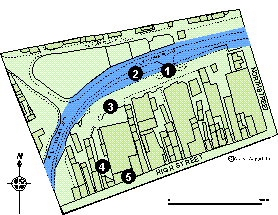 Elgin: Area 2
Elgin: Area 2This page was copied from: http://www.suat.demon.co.uk/elgin_bs/elgin_a2.htm for informational and historical purposes. Please note original copyright at bottom of page. Duffuses had an early presence in Elgin.
 Elgin: Area 2
Elgin: Area 2

This area is defined by High Street to the south, Blackfriars Road to the north, the relief road (Alexandra Road) to the west and North Street to the east. It includes a large stretch of High Street frontage and the site of the only archaeological work on this part of the frontage (no 5).
Click here for a full size map (28K)
Trial excavations by W. J. Lindsay in 1976 in advance of the relief road located rubble and garden soil.
Trial excavations by W. J. Lindsay in 1976 in advance of the relief road located natural sand at c 0.5 m.
Excavations in 1977 in advance of the relief road located waterlogged deposits. A series of four property boundary fences of 13th-15th century date were discovered and thirty cess pits of similar date. A 14th century oak barrel well was found intact as was a 16th century timber soakaway (Lindsay 1977, 24).
Excavations in 1981 by UAU in advance of a proposed shopping development located substantial backland deposits c 40 m back from the High Street. Deposits close to the street frontage had been scarped away by later building work. (Hall 1982, 13).
Excavations in 1993 by SUAT in advance of a proposed office development located badly damaged deposits on the High Street frontage. Some medieval pottery was recovered. (Mackenzie 1993, 40).
The extensive archaeological work on the former Nicholson's garage site gives a useful insight into archaeological survival in this area. Deposit survival on the High Street frontage is very poor, and for most of the frontage may be non-existent. Further north survival begins to get better, the interface probably existing at c 30-40 m north of the frontage. At this point waterlogged material begins to appear as recovered in Lindsay's excavations of 1976/77 (Lindsay 1977, 24). As is more clearly apparent in other areas (Area 3 for example), strips of well preserved archaeology may exist under current and former close lines. In short, any development to the rear of the High Street may require full excavation, whilst work on the frontage should certainly be monitored at least.
Copyright © Scottish Urban
Archaeological Trust Limited
55 South Methven Street, PERTH, PH1 5NX
Tel: +44 (0)1738 622393
Fax: +44 (0)1738 631626
E-Mail: [email protected]